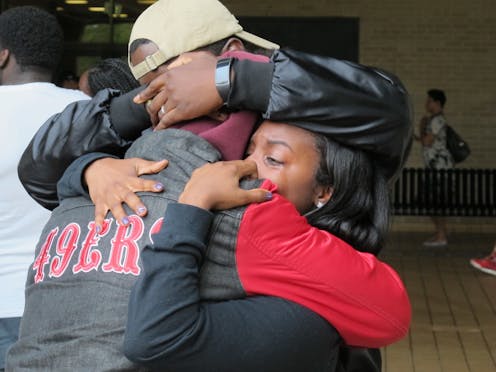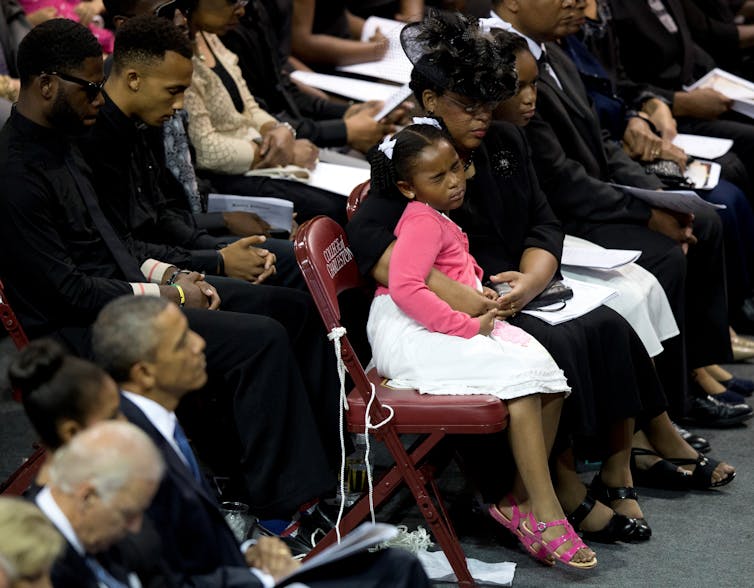Are many hate crimes really examples of domestic terrorism?
Like the death of Heather Heyer in Charlottesville, the murder of Richard Collins III was a symptom of violent extremism that should be treated accordingly.

A Maryland grand jury has indicted Sean Urbanski for allegedly murdering an African-American student in May.
Urbanski, a white former University of Maryland student who belonged to the racist Alt-Reich: Nation Facebook group, is facing a hate crime charge in the death of Richard Collins III. The victim had recently been commissioned as a second lieutenant in the U.S. Army and was days away from his graduation from another Maryland school.
While it makes sense to prosecute this murder as a hate crime, my 15 years experience of studying violent extremism in Western societies has taught me that dealing effectively with far-right violence requires something more: treating its manifestations as domestic terrorism.
Domestic terrorism
This growing domestic menace deserves more attention than it’s getting.
Terrorism is a form of psychological warfare. Most terrorist groups lack the resources, expertise and manpower to defeat state actors. Instead, they promote their agenda through violence that shapes perceptions of political and social issues.
I believe that the Maryland murder, if it was motivated by racist sentiments, should be treated as an act of domestic terrorism – which I define as the use of violence in a political and social context that aims to send a message to a broader target audience.
Like lynching, cross-burning and vandalizing religious sites, incidents of this kind deliberately aim to terrorize people of color and non-Christians.
I consider domestic terrorism a more significant threat than the foreign-masterminded variety in part because it is more common in terms of the number of attacks on U.S. soil. For example, my report published by the Combating Terrorism Center at West Point identified hundreds of domestic terror incidents per year from 2008 to 2012.
Another report, initially published in 2014 by New America Foundation on domestic incidents of extremist violence, shows that far-right affiliated perpetrators conducted 18 attacks that killed 48 people in the United States from 2002 to 2016 (excluding the Orlando nightclub massacre). Over the same period, terrorists motivated by al-Qaida’s or the Islamic State’s ideology killed 45 people in nine attacks.
The Orlando mass shooting, given its mix of apparent motives, is hard to categorize. That attack killed 49 people.
A spontaneous appearance
In briefings with law enforcement and policymakers, I have sometimes encountered a tendency to see U.S. right-wing extremists as a monolith. But traditional Ku Klux Klan chapters operate differently than skinhead groups, as do anti-government “patriot” and militia groups and anti-abortion extremists. Christian Identity groups, which believe Anglo-Saxons and other people of Northern European descent are a chosen people, are distinct too.
Certainly, there is some overlap. But these groups also differ significantly in terms of their methods of violence, recruitment styles and ideologies. Across the board, undermining the threat they pose requires a more sophisticated approach than investigating their criminal acts as suspected hate crimes.
In an ongoing study I’m conducting at the University of Massachusetts Lowell with several students, we have determined that, as apparently occurred with Collins’ murder in Maryland, many attacks inspired by racist or xenophobic sentiments may appear spontaneous. That is, no one plans them in advance or targets the victim ahead of time. Instead, chance encounters that enrage the perpetrators trigger these incidents.
Sporadic attacks with high numbers of casualties that are plotted in advance, such as Dylann Roof’s murder of nine African-Americans in a Charleston, South Carolina church, are always big news. More typical incidents of far-right violence tend to draw less attention.

The fatal stabbing of Taliesin Myrddin Namkai Meche and Ricky John Best aboard a train in Portland, Oregon in late May is one exception. The alleged killer of these two white men, Jeremy Joseph Christian, attacked them with a knife after they stood up to him for haranguing two young women who appeared to be Muslim, police said.
Much of the extensive media coverage focused on Christian’s violent and racist background.
Given the spontaneous nature of so much far-right violence, U.S. counterterrorism policies should, in my view, target the dissemination of white supremacist ideology, rather than just identifying planned attacks and monitoring established white supremacy groups.
An iceberg theory
The number of violent attacks on U.S. soil inspired by far-right ideology has spiked since the beginning of this century, rising from a yearly average of 70 attacks in the 1990s to a yearly average of more than 300 since 2001. These incidents have grown even more common since President Donald Trump’s election.
The Southern Poverty Law Center, a nonprofit that researches U.S. extremism, reported 900 bias-related incidents against minorities in the first 10 days after Trump’s election – compared with several dozen in a normal week – and the group found that many of the harassers invoked the then-president-elect’s name. Similarly, the Anti-Defamation League, a nonprofit that tracks anti-Semitism, recorded an 86 percent rise in anti-Semitic incidents in the first three months of 2017.
Beyond the terror that victimized communities are experiencing, I would argue that this trend reflects a deeper social change in American society.
The iceberg model of political extremism, initially developed by political scientist Ehud Shprinzak can illuminate these dynamics.
Murders and other violent attacks perpetrated by U.S. far-right extremists compose the visible tip of an iceberg. The rest of this iceberg is under water and out of sight. It includes hundreds of attacks every year that damage property and intimidate communities, such as the attempted burning of an African-American family’s garage in Schodack, New York. The garage was also defaced with racist graffiti.
Data my team collected at the Combating Terrorism Center at West Point show that the significant growth in far-right violence in recent years is happening at the base of the iceberg. While the main reasons for that are still not clear, it is important to remember that changes in societal norms are usually reflected in behavioral changes.
Hence, it is more than reasonable to suspect that extremist individuals engage in such activities because they sense that their views are enjoying growing social legitimacy and acceptance, which is emboldening them to act on their bigotry.
Budget cuts
Despite an uptick in far-right violence and the Trump administration’s plan to increase the Department of Homeland Security budget by 6.7 percent to US$44.1 billion in 2018, the White House wants to cut spending for programs that fight non-Muslim domestic terrorism.
The federal government has also frozen $10 million in grants aimed at countering domestic violent extremism. This approach is bound to weaken the authorities’ power to monitor far-right groups, undercutting public safety.
How many more innocent people like Richard Collins III have to die before the U.S. government starts taking the threat posed by violent white supremacists more seriously?
This is an updated version of an article originally published on May 28, 2017.
Arie Perliger does not work for, consult, own shares in or receive funding from any company or organization that would benefit from this article, and has disclosed no relevant affiliations beyond their academic appointment.
Read These Next
A year on, the Israeli-Lebanese ceasefire looks increasingly fragile − could a return to cyclical vi
Since the start of the truce on Nov. 27, 2024, there have been thousands of Israeli violations inside…
Pentagon investigation of Sen. Mark Kelly revives Cold War persecution of Americans with supposedly
President Donald Trump and his supporters cast their domestic opponents as disloyal, traitorous or worse,…
When darkness shines: How dark stars could illuminate the early universe
Some unique ‘stars’ might be fueled by dark matter annihilation.






